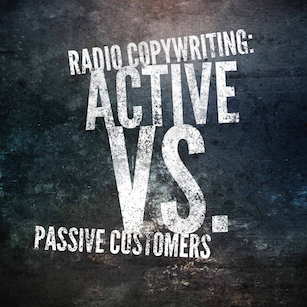I was recently re-reading your article called “Before You Begin Writing A Spot, Ask…”
And one of the questions says, “Is the product or service targeted at active or passive customers?”
Some newer business owners may not know how to answer that, or they may have different ideas on what kind of customer is considered “active” or “passive,” and I doubt I could explain it as well as you.
Can you provide a basic definition?”
Dan Replies:
Sure.
Let’s start with one of my key tenets:
Radio Advertising Solves Problems.
One of your listeners has a problem that they can’t solve themselves.
Your advertiser has the (not “a”) solution to that person’s problem.
The commercial acts as a “matchmaker” between the two.
An active customer is someone who is suffering from the problem and needs that solution now:
They have a terrible toothache but don’t have their own “regular” dentist.
Their challenge isn’t to find “a” dentist.
It’s to find the right dentist to solve their problem.
A passive customer is someone who will need the solution provided by the advertiser’s product or service.
They might need it “sooner or later.”
Or it might be something they want to do or know they need to do, but it’s oh-so-easy to put off until some other time.
Joining a health club?
Making a will?
Finally doing something about that that backyard fence that needs to be repaired or, more likely, replaced?
None of those is urgent.
They can let it go another week, another month, another six months without suffering any noticeable consequences.
(Unless they happen to die during that time period, in which case their family might suffer the effects of their having died without leaving a will.)
Your advertiser wants to say to the active customer, “Hey! We’ll handle it for you. Take this action (telephone, email, website visit, walk in) now, and we’ll do the rest. We’ll solve that problem for you.”
A common example of passive customers for dentists is someone who recently moved to your community. They don’t need a dentist now, but eventually they will.
Or they have toddlers and know that, to be a responsible parent, they’ll need to take the kiddies to the dentist’s office every six months or so.
Your advertiser wants to say to the passive customer, “You are going to have this problem. And when you do, we are the ones who will fix it for you.”
If you were to advertise the emergency telephone number, 9-1-1 (or 9-9-9 in the UK or 1-2-2 in the EU), you’d be targeting passive customers.
Right now, they don’t need to call 9-1-1. They’re not faced with an emergency situation.
But if they might suffer an emergency sometime in the future, they need to learn now what phone number they should call.
An active customer would be someone who at this very moment is experiencing an emergency.
If that person hasn’t already learned “In an emergency, call 9-1-1,” this probably isn’t the time for a radio ad campaign to educate them.
==============
Because earlier in this article we referenced the dental profession, this is a good time to make sure you know about this radio commercial for dentists. It targets active customers.










